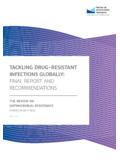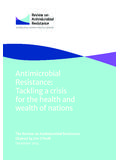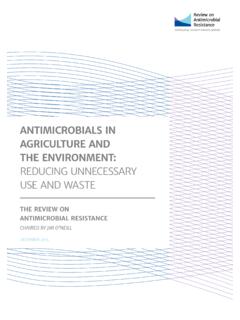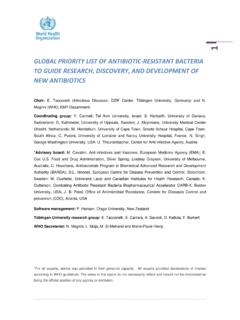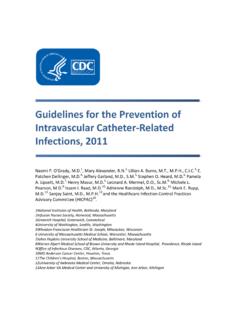Transcription of TACKLING DRUG-RESISTANT INFECTIONS GLOBALLY - AMR …
1 TACKLING DRUG-RESISTANT . INFECTIONS GLOBALLY : FINAL REPORT AND. RECOMMENDATIONS. THE REVIEW ON. antimicrobial resistance . CHAIRED BY JIM O'NEILL. MAY 2016. CONTENTS. FOREWORD BY JIM O'NEILL .. 1. EXECUTIVE SUMMARY.. 4. 1. THE PROBLEM: WHY TACKLING AMR IS ESSENTIAL.. 10. 2. WE MUST REDUCE THE DEMAND FOR ANTIMICROBIALS SO. THE CURRENT STOCK OF DRUGS LASTS LONGER .. 17.. INTERVENTION 1: A GLOBAL PUBLIC AWARENESS CAMPAIGN.. 19. INTERVENTION 2: IMPROVE SANITATION AND PREVENT THE SPREAD OF INFECTION.. 21. INTERVENTION 3: REDUCE UNNECESSARY USE OF ANTIMICROBIALS IN. AGRICULTURE AND THEIR DISSEMINATION INTO THE ENVIRONMENT.
2 24. INTERVENTION 4: IMPROVE GLOBAL SURVEILLANCE OF DRUG resistance . AND antimicrobial CONSUMPTION IN HUMANS AND ANIMALS.. 32. INTERVENTION 5: PROMOTE NEW, RAPID DIAGNOSTICS TO REDUCE. UNNECESSARY USE OF ANTIMICROBIALS .. 35. INTERVENTION 6: PROMOTE development AND USE OF VACCINES. AND ALTERNATIVES .. 40. INTERVENTION 7: IMPROVE THE NUMBER, PAY AND RECOGNITION. OF PEOPLE WORKING IN INFECTIOUS DISEASE .. 44. 3. WE MUST INCREASE THE SUPPLY OF NEW ANTIMICROBIALS. EFFECTIVE AGAINST DRUG RESISTANT BUGS .. 47. INTERVENTION 8: A GLOBAL INNOVATION FUND FOR EARLY STAGE. AND NON COMMERCIAL R&D.. 49. INTERVENTION 9: BETTER INCENTIVES TO PROMOTE INVESTMENT FOR NEW DRUGS.
3 AND IMPROVING EXISTING ONES .. 52. 4. HOW TO PAY FOR IT: TACKLING AMR IS AFFORDABLE.. 64. 5. IDEAS FOR IMPLEMENTATION AND NEXT STEPS.. 69. SUMMARY OF RECOMMENDATIONS .. 73. ACKNOWLEDGEMENTS .. 76. ACRONYMS AND ABBREVIATIONS. AMC Advance Market Commitment IPC Infection prevention and control AMR antimicrobial resistance JPIAMR Joint Programming Initiative on antimicrobial resistance APIs Active pharmaceutical ingredients MDR Multi-drug resistant BARDA Biomedical Advanced Research and development MPP Medicines Patent Pool Authority MRSA Methicillin-resistant Staphylococcus aureus CDC US Centers for Disease Control and Prevention MSF M decins Sans Fronti res (Doctors without Borders).
4 CFCs Chlorofluro carbons ND4BB New Drugs For Bad Bugs DDD Defined Daily Dose NGO Non-government organisation DMS Diagnostic Market Stimulus NIH US National Institutes of Health DNDi Drugs for Neglected Diseases Initiative OECD Organisation for Economic Cooperation and EMA European Medicines Agency development EU European Union OIE World Organisation for Animal Health FAO Food and Agriculture Organization of the United Nations OTC Over-the-counter FDA US Food and Drug Administration PD Pharmacodynamics FDC Fixed Dose Combination PK Pharmacokinetics FIND Foundation for Innovative New Diagnostics PMDA Pharmaceutical and Medical Devices Agency (Japan).
5 G20 The Group of 20 (Argentina, Australia, Brazil, Canada, R&D Research and development China, France, Germany, India, Indonesia, Italy, Japan, SARS Severe Acute Respiratory Syndrome South Korea, Mexico, Russia, Saudi Arabia, South Africa, Turkey, United Kingdom and United States, plus the SDGs UN Sustainable development Goals European Union). TB Tuberculosis G7 The Group of Seven (Canada, France, Germany, Italy, UDR Usual drug resistance Japan, United Kingdom, and United States). UK United Kingdom GARD Global Antibiotic Research & development UN United Nations Gavi Gavi, the Vaccine Alliance US United States GBP British Pound USD US Dollar GDP Gross domestic product WHA World Health Assembly GHRF Global Health Risk Framework for the Future WHO World Health Organization GHSA Global Health Security Agenda 3Ps Push, Pull, Pool' initiative for TB drug development GLASS Global antimicrobial resistance Surveillance System HCAI Healthcare-associated infection IDA International development assistance IMI Innovative Medicines Initiative 1.
6 FOREWORD BY JIM O'NEILL. When I was asked to chair the Review on antimicrobial As with all forecasts of this sort, it is of course possible that resistance (AMR), I was told that AMR was one of the our estimates may turn out to be too large, but we believe it biggest health threats that mankind faces now and in the is even more likely that they could be too small. This is because coming decades. My initial response was to ask, Why should an we did not even consider the secondary effects of antibiotics economist lead this? Why not a health economist?' The answer losing their effectiveness, such as the risks in carrying out was that many of the urgent problems are economic, so we caesarean sections, hip replacements, or gut surgery.
7 And in the need an economist, especially one versed in macro-economic short 19 months since we started, new forms of resistance have issues and the world economy, to create the solutions. emerged that we did not contemplate occurring so soon, such as the highly disturbing discovery of transferable colistin resistance , I have very much kept this in mind ever since that first reported in late 2015. conversation and it has framed my team's approach. Since setting out the scale of the problem if we do not act, It is now clear to me, as it has been to scientific experts for a we have been making recommendations on how we can avoid long time, that TACKLING AMR is absolutely essential.
8 It needs to such a terrible scenario. Whatever the exact number, which of be seen as the economic and security threat that it is, and be at course we hope will never become a reality, the 100 trillion USD. the forefront of the minds of heads of state, finance ministers, cost of inaction means that our recommended interventions agriculture ministers, and of course health ministers, for years are extremely good value for money on a relative basis. to come. There has already been some exciting progress since we As has now become widely cited, our very first paper outlined began to set out our proposed solutions.
9 In February 2015, we a world in 2050 where AMR is the devastating problem it recommended that a dramatic boost in surveillance was needed threatens to become unless we find solutions. I deliberately to track resistance , especially in the emerging world. We are very chose 2050 as it is the same timeframe associated with the pleased in this regard, that the UK government has initiated so called BRIC (Brazil, Russia, India and China) inspired world the Fleming Fund to improve disease surveillance focused on that I became well-known for. We employed two consultancy DRUG-RESISTANT INFECTIONS in low and middle-income countries, teams, KPMG and Rand, to undertake detailed scenario analyses, and has contributed 375 million USD to it.
10 This work is incredibly which provided the basis for our conclusions. As is now quite important for TACKLING AMR and it must go hand in hand with well known, we suggested that without policies to stop the the recent impetus to achieve truly effective global disease worrying spread of AMR, today's already large 700,000 deaths surveillance and to make sure that health systems are better every year would become an extremely disturbing 10 million prepared for epidemics. every year, more people than currently die from cancer. Indeed, even at the current rates, it is fair to assume that over one We also recommended that more research funding is needed million people will have died from AMR since I started this for AMR to kick-start early research into new antimicrobials Review in the summer of 2014.
